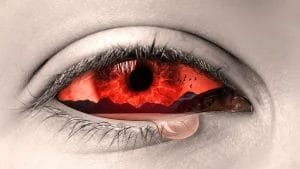A Group of Primary Headache Disorders
 Trigeminal autonomic cephalalgia (TAC) is a group of primary headache disorders. The one most commonly heard of is cluster headache.
Trigeminal autonomic cephalalgia (TAC) is a group of primary headache disorders. The one most commonly heard of is cluster headache.
This group of headache disorders is different than migraine and it is important to know the differences. TACs are strictly unilateral, which means they cause symptoms only on one side of the head. They usually involve symptoms such as a red watery eye, stuffy or runny nose, forehead sweating, swollen droopy eye, and/or unilateral pupil constriction – these are known as cranial parasympathetic autonomic features. While this group of headache disorders has these common traits and are known as TACs, there are also important differences which help determine the most appropriate diagnosis
Cluster Headache
Cluster headache is the most common diagnosis of the TACs. While it was once thought to be primarily a diagnosis for men, now that the stigma is starting to be addressed, more women are being diagnosed. Currently the diagnosis rate is 3-4 male to 1 female, so the opposite that we see with migraine diagnoses, and it is a different headache disorder than migraine.
- The length of attacks typically ranges from 15 min to 3 hours.
- Attacks range from once every other day to 8 or more per day.
- 85% of patients are episodic, and their attacks come in cycles that can range from 2 weeks to 12 months.
- A patient who remains in cycle beyond 12 months without a 3 month remission is diagnosed as having chronic cluster headache.
- There is normally a predominant side, but attacks can switch sides from one cycle to the next.
- Treatments commonly include preventive options such as Emgality and Verapamil as well as abortive options such as oxygen.
Paroxysmal Hemicrania and Hemicrania Continua
Paroxysmal Hemicrania (PH) and Hemicrania Continua (HC) typically respond well to indomethacin, and that is the primary treatment for both of them. A healthcare provider may prescribe a course of this medication in order to determine if a patient has one of these diagnoses before looking further into the other possible TACs. Beyond the indomethacin response, the timing of these two diagnoses are extremely different.
- Hemicrania continua: described as a constant ache with spikes of stabbing pain with autonomic features. It’s the headache that never goes away, but rather just increases and decreases in intensity. If hemicrania continua does not respond to indomethacin, which can happen for many reasons, then treatments become trial and error.
- Paroxysmal hemicrania: attacks last 2-45 minutes each, and a patient may experience 1-40 of them per day. The attacks may come in cycles (episodic) or the person may be chronic and never go into remission. Paroxysmal hemicrania has mixed response with high flow oxygen but it can be a useful tool for some.
Short-Lasting Unilateral Neuralgiform Headache Attacks (SUNHA)
SUNHA is currently considered the most rare of the TACs and is often described as a mini cluster attack that has been condensed to 5 – 500 seconds. The remission period may be seconds to minutes to hours, and it is possible to have more than 200 attacks per day! Those who experience remission periods are episodic and will have cycles, similar to some of the other TACs. However, others will experience the attacks daily and they are considered chronic. There are two forms of this diagnosis which are very similar:
- SUNCT: stands for Short-lasting Unilateral Neuralgiform Headache Attacks with Conjunctival Injection and Tearing. This simply means that the symptoms include a red and watery eye during the attacks. However, other cranial autonomic symptoms are often experienced along with this as well.
- SUNA: stands for Short-lasting Unilateral Neuralgiform Headache Attacks with Cranial Autonomic Symptoms. This simply means that there is no red or watery eye symptoms, but that there is another cranial autonomic symptom. Currently there are not many options for treatment for SUNA, although the most common is lamotrigine.
The key differences between the various TACs can help a headache specialist figure out which one you are experiencing, or even if you have multiple diagnoses. Often people will need to see a certified headache specialist in order to get an accurate diagnosis, because of the complexity of these disorders. This can be challenging due to the shortage of these headache specialists, but getting the correct diagnosis is crucial in helping you have access to the right treatment options, so that you can better manage life with TACs.